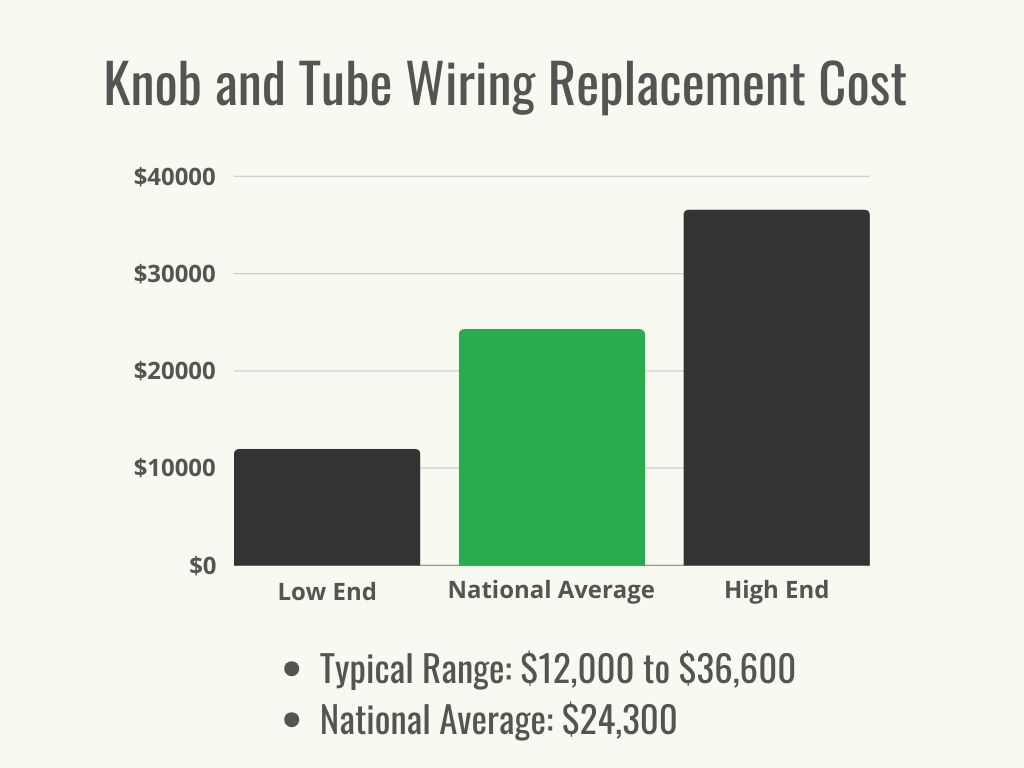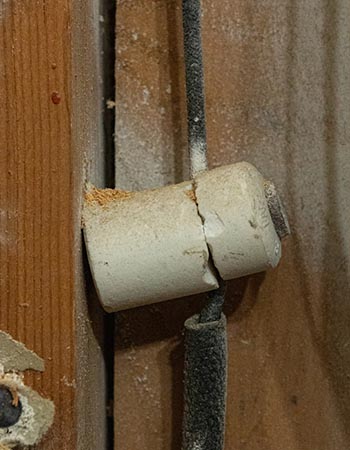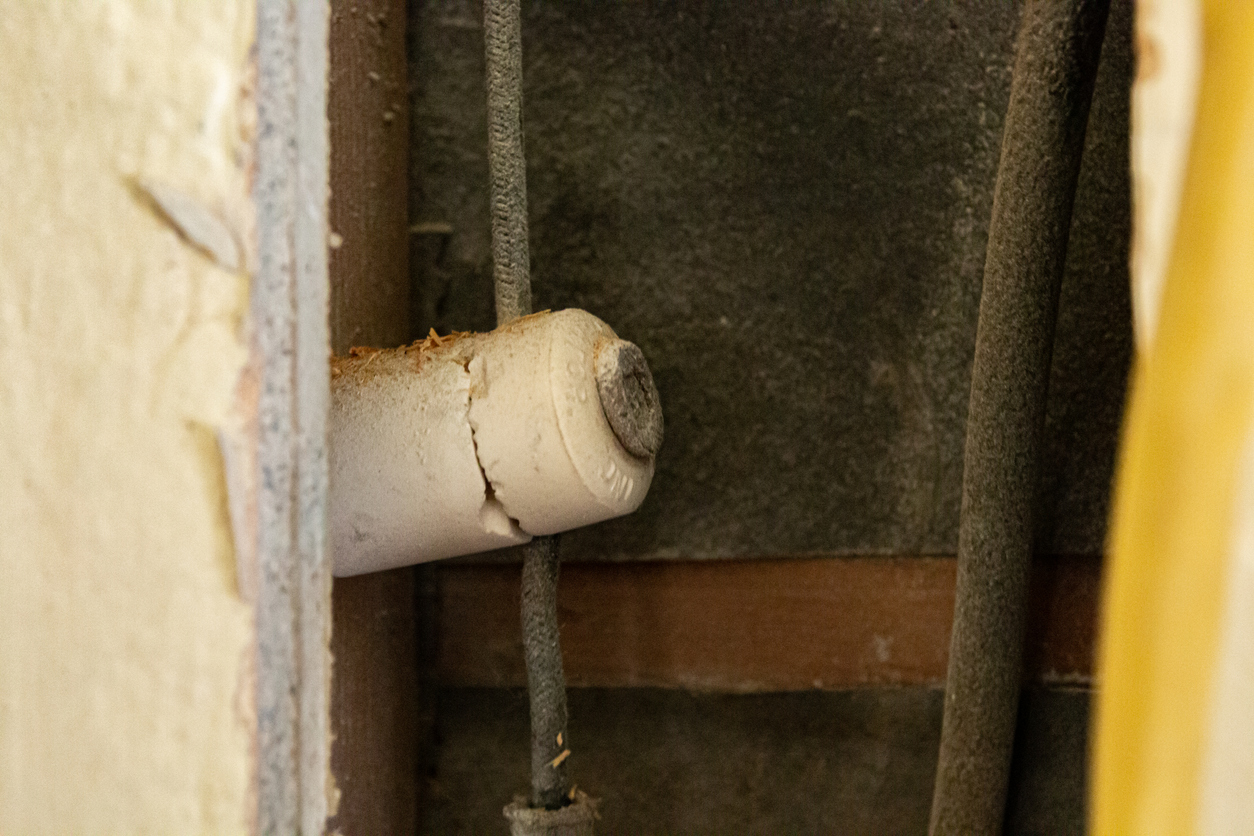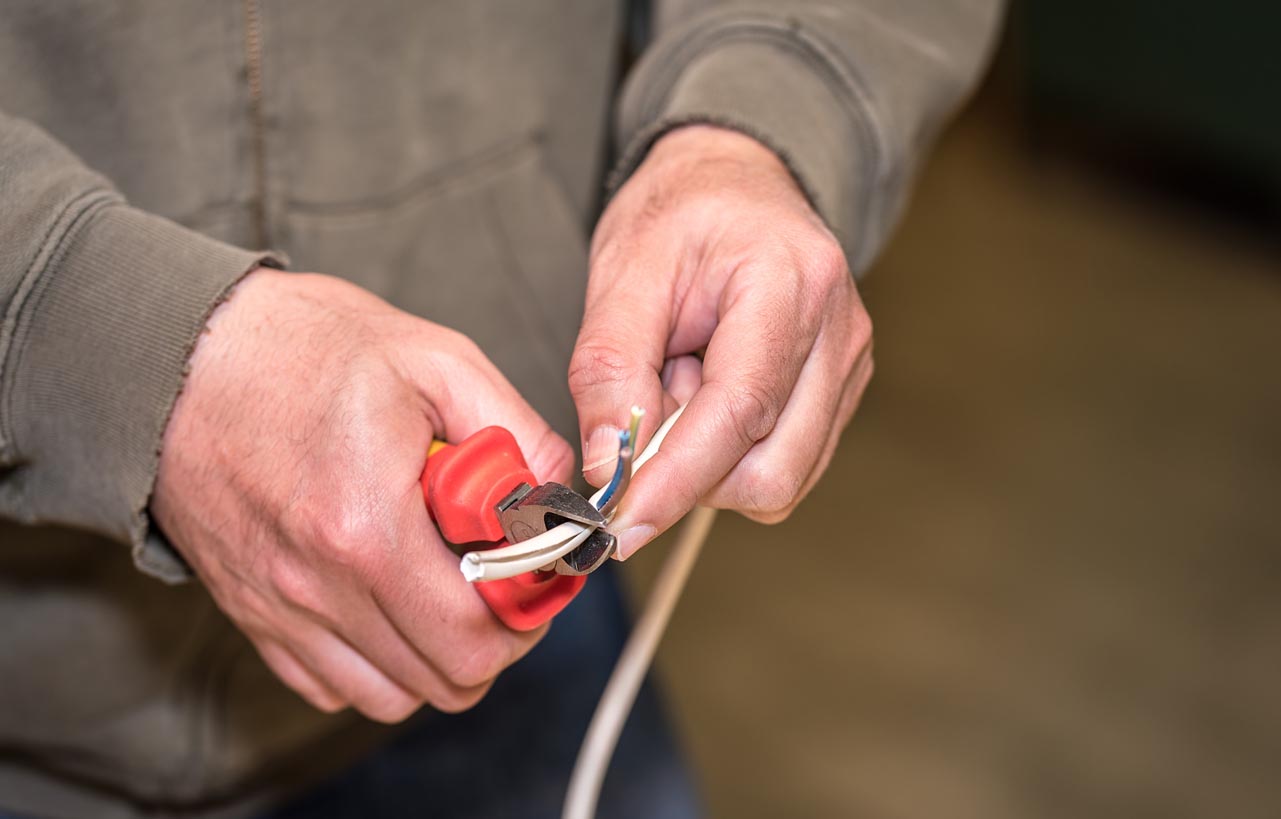

We may earn revenue from the products available on this page and participate in affiliate programs. Learn More ›
Highlights
- Knob and tube wiring replacement costs are higher than many other home improvement projects at $24,300 on average or between $12,000 and $36,600.
- Homeowners can expect home size, accessibility of the wiring and panels, labor fees, permits, repairs, and electrical upgrades, to influence the total cost to replace knob and tube wiring.
- Upgrading to a modern electrical system offers homeowners a safer environment, improved energy efficiency, decreased energy costs, and improved home salability.
- Electrical rewiring projects come with inherent risks during the installation and after, so homeowners are advised to hire a qualified electrician. In many cities, electrical upgrades must be completed by a licensed electrician in order to obtain necessary permits.
According to the International Association of Certified Home Inspectors (InterNACHI), knob and tube wiring is an older electrical system that was first introduced in the late 1800s and lasted into the early 20th century. While it’s no longer used today, homeowners may come across properties that rely on a knob and tube wiring system during their home-buying process. Knob and tube wiring can be dangerous if it’s not properly maintained or if it’s overloaded, which is why many people opt to replace the system sooner than later to meet modern safety standards.
Replacing a knob and tube system can be a significant investment, with costs ranging from $12,000 to $36,600 depending on several factors, such as house size and local permit costs. The national average knob and tube wiring replacement cost is $24,300, as reported by Angi. While the price may be a higher investment than expected, the benefits can help ensure the safety of the household and reduce electricity usage and costs in the long run.

What is knob and tube wiring? Why do I need to replace it?
Knob and tube wiring is a type of early electrical system that proved relatively easy to install and played an important role in introducing electricity to homes. However, it is considered unsafe by today’s standards. “Knob and tube wires encompass ceramic ‘knobs’ and ‘tubes’ that carry electricity throughout your home,” explains Dan Mock, the vice president of operations at Mister Sparky, an electrical franchise company with locations across the U.S. “These cables might look similar to the ones used today, but they are dangerous. This is because they contain no ground wire, which increases the chances of an electrical spark. K&T (knob and tube) wires, therefore, could cause a fire in your home.”
In addition to knob and tube wiring outlets lacking grounding capabilities, the insulation in knob and tube electrical wiring can become brittle and crack, creating a fire risk. A knob and tube wiring system is also unlikely to be able to handle the electrical needs of a modern home. In some areas, it’s impossible to secure knob and tube wiring insurance for a home due to the additional risks the systems impose. For these reasons, replacing a knob and tube wiring system is considered a necessary and wise investment.
Factors in Calculating Knob and Tube Wiring Replacement Cost
There are several main factors homeowners will need to consider when calculating knob and tube wiring replacement cost. For example, larger homes will likely require more materials and labor than smaller homes, resulting in higher costs. Homeowners can also factor permits and labor fees into their budget when they are replacing knob and tube wiring.
Home Size
The cost of rewiring a house depends heavily on its size. The larger the square footage of a home, the more wiring, fixtures, switches, and outlets it is likely to require. Larger homes also tend to have more custom features, such as vaulted ceilings, elaborate lighting setups, or specialty rooms (like a media room), which may require specialized electrical work.
While having a smaller home doesn’t guarantee a low knob and tube wiring replacement cost, it often means a more straightforward and cost-effective process. Homeowners can expect to pay a new construction electrical cost per square foot of $10 to $20 to rewire their home. Using a rewiring cost calculator or reviewing average costs for each item can help homeowners determine an accurate budget.
| Home Size | Average Cost (Materials and Labor) |
| 800 square feet | $8,000 to $16,000 |
| 1,300 square feet | $13,000 to $26,000 |
| 1,600 square feet | $16,000 to $32,000 |
| 2,000 square feet | $20,000 to $40,000 |
| 2,500 square feet | $25,000 to $50,000 |
| 3,000 square feet | $30,000 to $60,000 |
Accessibility
Electrical wiring costs for a new house are often the cheapest since the walls have not been sealed up yet. However, replacing wiring in existing homes is more challenging. Since knob and tube wiring was prevalent in homes built between the 1880s and the 1940s, it’s not uncommon to come across certain structural elements, such as plaster walls or historic architecture, that make it more challenging to update the wiring.
Homes without easy access often require specialized skills and equipment to safely replace knob and tube wiring systems, significantly boosting the overall price to rewire a house. When budgeting for a replacement, homeowners can consult with a pro about how accessible their home is to account for any complications that might affect costs.
Labor
Labor costs can make up a large portion of the cost to rewire an old house. But just how much does an electrician cost? Professional electricians typically charge hourly rates of $50 to $100 for their services. Since wiring replacement projects can take weeks, electrical wiring pricing can start to add up.
Some electricians charge a flat rate per project or for each outlet, fixture, or switch being replaced. These charges can range from $100 to $350 or more, depending on the complexity of the work. To avoid costly surprises, it’s important for homeowners to clarify what is and is not included in labor costs when replacing wiring, from preparation and installation to finishing work and cleanup.
Permits and Inspections
Permits and inspections are mandatory in most areas when house wiring systems are being updated. This is to ensure the electricians will comply with current safety and building code requirements. Homeowners can expect to pay between $100 and $125 per permit on average, though pricing can range from as little as $10 to as much as $500. Not securing the necessary permits for electrical work can result in fines or legal consequences—not to mention safety hazards from the work itself.
Both pre- and post-inspections are likely to be required when homeowners are replacing knob and tube wiring. Homeowners can expect to pay between $100 and $150 per inspection. While they are an added cost, these inspections provide an additional layer of safety assurance beyond work done by a professional electrician, who will ensure the work meets the required standards.

Additional Costs and Considerations
In addition to the cost-influential factors that affect most rewiring jobs, there are a few other considerations homeowners will want to be aware of. Homeowners can avoid going over budget on knob and tube wiring upgrades by understanding how these factors affect electrical house wiring replacement costs.
Electrical Panel Upgrade
Also known as a breaker box, an electrical panel distributes electricity from the main power source to all the different areas of a home and property. When replacing knob and tube wiring, electricians will usually upgrade the electric panel to a higher amperage to accommodate increased electrical needs. This is crucial since modern homes have many more appliances and electronics that draw more power. Where knob and tube systems usually run on a 60-amp electrical box, most homes require at least 100 amps or as many as 400 amps to operate safely.
Whether the panel needs to be replaced will depend on the panel’s age, capacity, and compatibility with the new electrical system. Homeowners can expect around $1,274 as the cost to replace an electrical panel.
Repairs
After a knob and tube wiring system has been replaced, wall repairs are often required to restore a home to its previous state. While some projects may need only a few small patches, others may require full drywall replacement. Repairing the walls often comes at an additional cost beyond the price to rewire the electrical system.
The type of wall that needs repair will affect the cost of drywall repairs. Most modern homes are built with drywall, but older homes may use a lath and plaster combination, both of which have their own repair price. For example, drywall repairs average $50 to $150 per square foot, with a total average cost range of $60 to $900. Repairing lath and plaster walls will run $80 to $200 per square foot.
Cleanup and Disposal
Post-project cleanup typically involves removing debris, dust, and any discarded materials. The cost of cleanup and disposal could be between $300 and $500, depending on whether the electrician can haul away the garbage or if a dumpster rental is required for drywall debris.
Homeowners may want to hire one of the best cleaning services (like The Maids or Merry Maids) if they prefer not to clean the drywall dust or other debris themselves. Depending on the home’s size and cleaning scope, house cleaning costs range from $30 to $250 per hour.
Electrical Upgrades
Replacing knob and tube wiring often involves upgrading outlets, switches, and lighting fixtures to accommodate the electrical demands of modern appliances and electronics. It’s also the perfect time to add any convenience upgrades, such as 3-way switch wiring or additional light fixtures. Current codes require that rooms have a sufficient number of outlets placed every 12 feet at minimum, according to the National Electrical Code (NEC).
Homeowners will want to budget accordingly to ensure that their home complies with local codes and can safely accommodate appliances such as larger refrigerators, TVs, and washers and dryers. Many outlets installed in bathrooms, kitchens, and laundry rooms are GFCI (ground fault circuit interrupter)-compliant, meaning the outlet automatically cuts power to help prevent sparking or current overload if a power surge is detected. The average installation cost of a GFCI outlet, including materials and labor, is $130 to $300.
| Type of Electrical Upgrade | Average Cost (Materials Only) |
| Ceiling fan | $150 to $360 each |
| Existing light switch replacement | $50 to $150 each |
| Existing outlet replacement | $125 to $250 each |
| GFCI grounded outlet | $10 to $25 each |
| Light fixture | $160 to $950 each |
| Light switch | $100 to $200 each |
| New electrical outlet | $140 to $300 each |
| Smart outlet | $25 to $50 each |
Benefits of Choosing Knob and Tube Wiring Replacement
In most scenarios, knob and tube replacement is necessary to bring a home up to code. But this doesn’t mean there aren’t additional benefits for the home’s occupants to enjoy. Homeowners can rest assured that there’s more safety and improved efficiency for starters.
Improved Safety
Upgrading home electrical wiring to a more modern system offers improved safety over a knob and tube wiring system for several reasons. Knob and tube wiring lacks adequate insulation, which can break down due to the higher continuous circuit of electricity running through it to power more appliances. These systems are also not designed to handle the electrical demands of modern homes and risk overheating. “With K&T there are no options to enable installation of modern safety protection devices such as GFCI (ground fault) or AFCI (arc fault),” adds Mock. “If you have K&T wires in your house, don’t panic. Hiring an electrician to upgrade these cables is simple and effective, and it might be less expensive than you think.”
Improved Efficiency
Old electrical wiring can lead to energy waste and higher utility bills. Modern systems are designed to work better with today’s appliances, lighting, and electronics, ensuring that all electrical components within a home operate at their best without unusual surges. This advantage can help extend the lifespan of appliances and reduce the need for repairs or premature replacements. Additionally, knob and tube systems are not compatible with current insulation materials because they dissipate heat into the air, which they can’t do if surrounded by insulation.
Decreased Electricity Costs
Updated electrical systems ensure appliances and electronics can operate at their peak performance without overloading the system and causing power surges. With less wasted energy, homeowners can expect a decrease in their monthly electricity bills after switching from a knob and tube system. There may be additional savings when homeowners purchase more energy-efficient appliances that can be accommodated with upgraded GFCI outlets and circuits. New and improved electrical systems also experience fewer performance issues, reducing the need for expensive repairs and extensive maintenance.
Improved Salability
Upgrading a home’s knob and tube wiring can improve the salability of a home. Homes with updated electrical systems are more likely to comply with current building codes. This can speed up the inspection process and make the sale process much smoother. Prospective buyers will also appreciate the fact that an updated electrical system means the home is safer and more efficient. If a homeowner is struggling to sell a home with knob and tube wiring, replacing the system can lead to a faster sale thanks to the competitive advantage a modern electrical system offers. “See this as a long-term investment,” says Mock. “Upgrading knob and tube wiring could increase the value of your home in the long run and provide you with peace of mind.”

Knob and Tube Wiring Replacement: DIY vs. Hiring a Professional
Home improvement upgrades can be costly, so it makes sense that homeowners would want to try to tackle projects on their own when possible to save money. However, those who have never dealt with this kind of system before will struggle to read a knob and tube wiring diagram, let alone carry out the replacement. According to Mock, “Removing K&T wires from your home is a bad idea if you don’t know what you’re doing. Older homes usually contain this wiring in basements, attics, and walls, but [it] can cause electrical shocks and even a fire. Therefore, you should call in a professional to do all the hard work for you. As a result, you can improve safety and compliance, and attract more homeowners if you plan to sell your property in the future.” It’s also worth noting that a permit is almost always required when a home’s electrical system is being replaced, and homeowners may find that those permits are granted only to licensed electricians who are fully trained to make the upgrades.
The good news is that hiring a professional to replace knob and tube wiring offers several benefits, including the following:
- Improved safety. Professionals have the proper training and experience to replace a knob and tube system safely regardless of how complex it is or how difficult it is to access. They also have the best electrician tools that are made specifically for these projects.
- Code compliance. Experienced electricians know how to adhere to local building codes and regulations since they must be licensed and have the proper training.
- Quality work. A professionally installed electrical system helps homeowners worry less because proper safety protocols are followed during installation.
When searching for an electrician, homeowners are advised to confirm that the electrician is licensed and insured to work in the local area. The right professional experience will help homeowners worry less about the time and complexity of a large project such as house rewiring.
How to Save Money on Knob and Tube Wiring Replacement Cost
The average cost to rewire a house with knob and tube wiring is $24,300. While much of the cost is made up of necessary labor fees, there are still ways to help homeowners manage knob and tube wiring replacement costs without affecting the quality.
- Obtain multiple quotes. Reaching out to multiple electricians for project quotes can help homeowners find the best value with a price near their budget.
- Choose budget-friendly fixtures. When replacing light and outlet fixtures, homeowners can reduce costs by choosing simpler fixtures that are functional yet cost-effective.
- DIY drywall repair or removal. Walls often need to be opened during knob and tube wiring replacements. For experienced DIYers, removing, replacing, or patching drywall is an option to help reduce the total cost.
- Touch up the paint. Similarly, paint often needs to be touched up after a knob and tube wiring replacement. This is another task some homeowners may feel comfortable handling themselves to save on labor costs.
- DIY debris cleanup. A junk removal service costs an average of $240. While that service may be necessary for large jobs, homeowners may be able to tackle debris cleanup on their own if they have the equipment and physical capacity to do so.
- Seek assistance. Some states offer qualifying homeowners a knob and tube removal grant, which can help absorb some of the replacement costs.
- Ask for discounts. Many companies offer discounts for certain groups of people, such as senior citizens, military members and their families, or first responders. It’s also possible that the company has special deals available around certain holidays.
Questions to Ask About Knob and Tube Wiring Replacement
Knowing how to hire a nearby electrician can make the difference between a quality job and a job that requires homeowners to hire a second contractor to help. Homeowners can ask an electrician many questions before hiring them for a knob and tube wiring replacement project to confirm experience, credentials, pricing, and project details.
- Are you a licensed and insured electrician?
- Can you provide references from previous wiring replacement projects, specifically with knob and tube systems?
- Do you offer a free on-site inspection?
- What is your approach to safety during an electrical system replacement?
- Does your quote include the costs of preparing the area, finishing the replacement, and handling the cleanup?
- Are there any potential hidden costs I should be aware of?
- What kind of wall damage can I expect from this rewiring project, and does the quote include necessary repairs?
- Will I need to rent a dumpster for debris removal?
- What is your pricing structure for upgrading the light fixtures, outlets, etc.?
- Will you secure the necessary permits for the replacement and schedule any inspections?
- Do you have experience with preserving historical features in homes that are considered historic landmarks?
- Will you inspect and update other electrical components at the same time, such as the breaker panel?
- How long will the replacement take? Can I remain at home throughout the project?
- How will you handle unexpected issues or complications that may arise during the project?
- What are your payment requirements and options?
- Do you offer any warranties or guarantees on your work?
FAQs
Once a pioneering electrical system, knob and tube wiring is no longer a practical or safe option. Replacing a home’s knob and tube wiring with an upgraded electrical system offers improved safety and efficiency features.
However, the process for updating a knob and tube system can be complex. The following answers to frequently asked questions may provide additional information that can help homeowners evaluating their electrical residential wiring replacement project.
Q. How long does knob and tube wiring last?
Knob and tube wiring can last up to 100 years since it’s made with copper wires. However, the insulation sheathing is often made of cloth, fabric, or rubber, all of which can deteriorate over a much shorter period of time. As the insulation becomes more brittle, it eventually breaks apart, creating a serious fire hazard. So while the copper wiring may have a long lifespan, the system as a whole does not.
As a result, knob and tube wiring is not recommended for long-term use or with higher-use appliances that require a continuous current that can overload the wires’ capabilities.
Q. How long does it take to replace knob and tube wiring?
Removing and replacing knob and tube wiring typically takes between 1 and 3 weeks. Several factors influence the replacement timeline, including the size of the house, the accessibility of the wiring, and the skill level of the electrician. This time period might not include the time to do extensive drywall repairs, since that is another time-consuming project. While replacing knob and tube wiring does take time, it’s a wise investment that makes a home more safe and valuable.
Q. Can you repair knob and tube wiring?
From a practical standpoint, it’s possible to repair parts of a knob and tube wiring system. But from a safety standpoint, replacement is usually the preferred option. These systems are considered outdated, and in many areas, simply repairing knob and tube wiring may not comply with modern electrical codes. If there are signs of an outdated electrical wiring system, homeowners will need to call in a professional to assess the system and offer guidance on the next best step.
Q. Is knob and tube wiring safe?
Knob and tube wiring may be safe if it was installed correctly, is not overloaded, and hasn’t been altered or spliced improperly. However, all existing knob and tube wiring systems are at least 70 years old. That means the wiring is deteriorating and likely overloaded by a higher number of large appliances. It’s also important to note that knob and tube systems do not have a ground wire, making them unsafe for kitchens, bathrooms, and laundry rooms, where GFCI outlets are now required.
Q. Do insurance companies cover knob and tube wiring?
Many homeowners insurance companies will refuse to cover a home that has knob and tube wiring, since it is not considered safe by modern electrical standards. However, some insurance companies may agree to provide coverage for homes with knob and tube wiring but will charge a high premium.
Q. Can I replace knob and tube wiring myself?
Not only is replacing your house’s electrical wiring without a license illegal in some states, but it is also dangerous and carries risks like electrical shock and house fires. Homeowners are advised to leave knob and tube wiring removal and replacement to a licensed and experienced professional electrician.
Q. Is it worth replacing knob and tube wiring?
Since tube and knob wiring is typically insufficient to support a modern household’s electrical needs and can also be a safety risk, it is worth replacing knob and tube wiring. Additionally, modern wiring is more energy efficient and may help homeowners save on energy bills by comparison.
Q. Can you rewire a house without removing walls?
In many cases, electricians can avoid removing walls when rewiring a house by accessing the wiring via the home’s crawl space. Homeowners will want to ask their electrician about whether this method is possible and if it will incur an additional cost.
Sources: Angi, HomeGuide, Redford Electric
